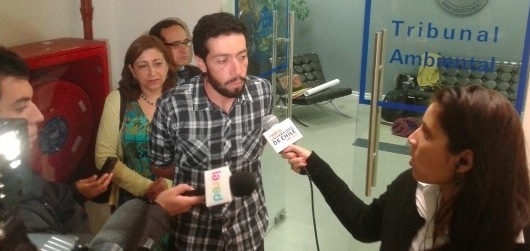Esta entrada también está disponible en: Spanish

Jhon Melendez, President of the Patay Co Indigenous Community Sued Barrick over Glacier Impacts
APRIL 10th, 2014 – Santiago Chile
On the one year anniversary of the suspension of Pascua Lama due to impacts to glaciers and other water resources, Jorge Daniel Taillant, Director of the Center for Human Rights and Environment (in Argentina) spoke for two hours today before Chile’s Environmental Tribunal to answer questions regarding reports CEDHA has produced to draw attention to Barrick Gold’s Pascua Lama project impacts to hitherto ignored but extremely relevant swaths of land called Periglacial Environments. These frozen hydrological resources help glaciated areas store and regulate water flow to downstream water basins for millions of people.
CEDHA’s testimony before Chile’s Environmental Court was in the form of a hearing in the environmental damage case filed by local residents and indigenous peoples in Chile’s Huasco Valley, downstream from Barrick’s operations at Pascua Lama. This area, suffering significant climate impacts, makes glaciers and other cryogenic resources (frozen resources) extremely vulnerable, argues CEDHA. These are critically important ecosystems, they are extremely delicate to anthropogenic impact, and have important hydrological value for the Huasco Valley, as hydrologically rich glacier and periglacial areas abound in the high mountain climates of the Central Andes.
“We are learning about the critical role glaciers play to downstream communities. Climate change is forcing us become more sensitive to our water resources. Periglacial areas, a much less-known glacial resource, but perhaps with even more significant hydrological value than many glaciers in some mountain environments, are especially important to water basins in warmer seasons and during drought years. Like glaciers, periglacial areas capture snow and ice as well as other atmospheric humidity in stretches of frozen land below glaciated areas, much like mountain wetlands in other regions. What’s remarkable about periglacial environments and what makes them extremely vulnerable is that they are invisible, showing no ice, since it resides beneath the surface of the Earth. Many mining operations, including Pascua Lama, have plowed their bulldozers straight into the ice, destroying these sensitive ecosystems. Barrick gold has carved roads into periglacial areas, and has programmed industrial acvitity at Pascua Lama that will destroy Periglacial Environments.” argued Taillant before the court.
CEDHA’s reports on Barrick Gold’s glacier and periglacial impacts can be found at:
1. Barrick’s Glaciers (Technical Report) https://center-hre.org/?p=13135&lang=en
2. Glaciers and Periglacial Environments in the Diaguita-Huascoaltino Indigenous Territory https://center-hre.org/?p=12271&lang=en
For more information:
Jorge Daniel Taillant
Centro de Derechos Humanos y Ambiente (CEDHA)
cel: +54 9 351 507 8376
www.cedha.org.ar
[email protected]
Jorge Daniel Taillant
Centro de Derechos Humanos y Ambiente (CEDHA)
cel: +54 9 351 507 8376
www.cedha.org.ar
[email protected]
